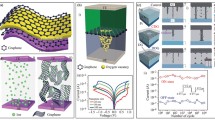Abstract
The development of nonvolatile memory is one of the urgent problems of contemporary science due to the rapid evolution of portable electronics. A promising trend in this field is the development of memristor structures able to change their resistance depending on the charge current through a memristor. The memristive effect in nitrogen-doped carbon nanotubes (CNT) is studied. It is established that the ratio between the resistances in high- and low-resistance states grows with an increase in the defectiveness of the carbon nanotubes to attain 4 × 105. It is shown that multilevel switching of the resistance determined by the recording voltage or deformation of a nanotube is possible in carbon nanotubes. The obtained results can be used for developing nonvolatile memory on the basis of CNTs corresponding to the condition of high scalability and multilevel switching.






Similar content being viewed by others
REFERENCES
J. Meena, S. Sze, U. Chand, et al., Nanoscale Res. Lett. 9, 526 (2014). https://doi.org/10.1186/1556-276X-9-526
K. Sun, J. Chen, and X. Yan, Adv. Funct. Mater. 2020, 2006773 (2020). https://doi.org/10.1002/adfm.202006773
D. S. Jeong and C. S. Hwang, Adv. Mater. 30, 1704729 (2018). https://doi.org/10.1002/adma.201704729
L. Wang, C. H. Yang, J. Wen, et al., J. Mater. Sci. Mater. Electron. 26, 4618 (2015). https://doi.org/10.1007/s10854-015-2848-z
W. Huh, D. Lee, and C. H. Lee, Adv. Mater. 2020, 2002092 (2020). https://doi.org/10.1002/adma.202002092
F. Pan, S. Gao, C. Chen, et al., Mater. Sci. Eng. R 83, 1 (2014). https://doi.org/10.1016/j.mser.2014.06.002
H. Wang, L. Hu, and W. Han, J. Alloys Compd. 854, 157200 (2021). https://doi.org/10.1016/j.jallcom.2020.157200
S. Lee, J.-B. Park, M.-J. Lee, et al., AIP Adv. 6, 125010 (2016). https://doi.org/10.1063/1.4971820
R. Singh, M. Kumar, S. Iqbal, et al., Appl. Surf. Sci. 536, 147738 (2021). https://doi.org/10.1016/j.apsusc.2020.147738
R. V. Tominov, Z. E. Vakulov, and V. I. Avilov, Nanomaterials 10, 1007 (2020). https://doi.org/10.3390/nano10051007
T. A. Bachmann, W. W. Koelmans, V. P. Jonnalagadda, et al., Nanotechnology 29, 035201 (2018). https://doi.org/10.1088/1361-6528/aa9a18
P. Viswanath, K. K. H. de Silva, H. H. Huang, et al., Appl. Surf. Sci. 532, 147188 (2020). https://doi.org/10.1016/j.apsusc.2020.147188
M. Brzhezinskaya, O. O. Kapitanova, O. V. Kononenko, et al., J. Alloys Compd. 849, 156699 (2020). https://doi.org/10.1016/j.jallcom.2020.156699
T. J. Raeber, Z. C. Zhao, B. J. Murdoch, et al., Carbon 136, 280 (2018). https://doi.org/10.1016/j.carbon.2018.04.045
M. V. Il’ina, O. I. Il’in, Y. F. Blinov, et al., Carbon 123, 514 (2017). https://doi.org/10.1016/j.carbon.2017.07.090
M. V. Il’ina, O. I. Il’in, A. V. Guryanov, et al., Fullerenes Nanotubes Carbon Nanostruct. 28, 78 (2020). https://doi.org/10.1080/1536383X.2019.1671370
M. V. Il’ina, O. I. Il’in, Yu. F. Blinov, V. A. Smirnov, and O. A. Ageev, Tech. Phys. 63, 1672 (2018).
Nanotechnologies in Microelectronics, Ed. by O. A. Ageev and B. G. Konoplev (Nauka, Moscow, 2019) [in Russian].
O. I. Il’in, M. V. Il’ina, N. N. Rudyk, et al., “Vertically aligned carbon nanotubes production by PECVD,” in Perspective of Carbon Nanotubes (InTech Open, Rijeka, 2019), p. 13. https://doi.org/10.5772/intechopen.84732
O. I. Il’in, M. V. Il’ina, N. N. Rudyk, et al., Nanosyst. Phys. Chem. Math. 9, 92 (2018). https://doi.org/10.17586/2220-8054-2018-9-1-92-94
O. Il’in, N. Rudyk, A. Fedotov, et al., Nanomaterials 10, 554 (2020). https://doi.org/10.3390/nano10030554
S. V. Bulyarskiy, D. A. Bogdanova, G. G. Gusarov, et al., Diamond Relat. Mater. 109, 108042 (2020). https://doi.org/10.1016/j.diamond.2020.108042
T. Sharifi, F. Nitze, and H. R. Barzegar, Carbon 50, 3535 (2012). https://doi.org/10.1016/j.carbon.2012.03.022
S. U. Lee, H. Mizuseki, and Y. Kawazoe, Nanoscale 2, 2758 (2010). https://doi.org/10.1039/c0nr00411a
S. H. Lim, H. I. Elim, and X. Y. Gao, Phys. Rev. B 73, 045402 (2006). https://doi.org/10.1103/PhysRevB.73.045402
M. V. Il’ina, O. I. Il’in, V. A. Smirnov, et al., “Scanning probe techniques for characterization of vertically aligned carbon nanotubes,” in Atomic-Force Microscopy and Its Application (IntechOpen, Rijeka, 2019), Chap. 13. https://doi.org/10.5772/intechopen.78061
A. M. Rao, D. Jacques, R. C. Haddon, et al., Appl. Phys. Lett. 76, 3813 (2000). https://doi.org/10.1063/1.126790
M. V. Il’ina, O. I. Il’in, A. V. Guryanov, et al., J. Mater. Chem. C 9, 6014 (2021). https://doi.org/10.1039/D1TC00356A
N. N. Rudyk, O. I. Il’in, M. V. Il’ina, et al., Tech. Phys. 66 (10) (2021, in press).
S. I. Kundalwal, S. A. Meguid, and G. J. Weng, Carbon 117, 462 (2017). .https://doi.org/10.1016/j.carbon.2017.03.013
M. Il’ina, O. Il’in, Y. Blinov, et al., Materials 11, 638 (2018). https://doi.org/10.3390/ma11040638
M. V. Il’ina, Yu. F. Blinov, O. I. Il’in, A. V. Guryanov, and O. A. Ageev, Bull. Russ. Acad. Sci.: Phys. 81, 1485 (2017).https://doi.org/10.3103/S1062873817120140
Funding
This study was financially supported by the ministry of Science and Higher Education of the Russian Federation within state task no. 0852-2020-0015 in the field of scientific activity.
Author information
Authors and Affiliations
Corresponding author
Additional information
Translated by E. Glushachenkova
Rights and permissions
About this article
Cite this article
Il’ina, M.V., Il’in, O.I., Osotova, O.I. et al. Memristive Effect in Nitrogen-Doped Carbon Nanotubes. Nanotechnol Russia 16, 821–828 (2021). https://doi.org/10.1134/S2635167621060082
Received:
Revised:
Accepted:
Published:
Issue Date:
DOI: https://doi.org/10.1134/S2635167621060082




